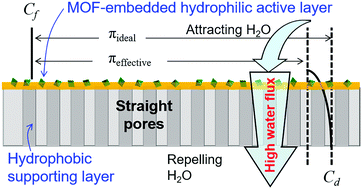Enhancing water permeability with super-hydrophilic metal–organic frameworks and hydrophobic straight pores
Abstract
High water flux and salt selectivity have been the most demanding goals for osmosis-based membranes. Osmotic pressure differences across membranes are particularly important in emerging forward osmosis and pressure retarded osmosis applications, and they are strongly dependent on internal concentration polarization (ICP) and water permeability. Here, we have studied the influence of hydrophobic straight pores perpendicular to the membrane plane and super-hydrophilic metal–organic frameworks (MOFs) on membrane performance. We found that straightening the pores in the supporting layer significantly reduced flow resistance. While water can pass through the hydrophobic supporting layer with minimal interaction, the hydrophilic MOF in the active layer effectively attracts water to the membrane, synergistically augmenting water permeability without considerable reduction of salt rejection. The low tortuosity by straightening the pores in the supporting layer clearly shows the benefit of increasing water permeability compared with a membrane whose pores are more tortuous. We also corroborated the effectiveness of MOF inclusion by varying its concentration, showing outstanding performance in water permeability compared with those of conventional and advanced thin-film composite membranes with high salt selectivity. This work presents a promising membrane configuration for further improving osmotic pressure by increasing the water flux.



 Please wait while we load your content...
Please wait while we load your content...